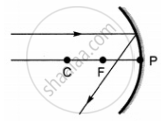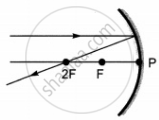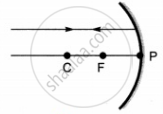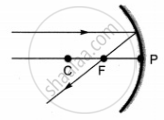Advertisements
Advertisements
Question
A bright object 50 mm high stands on the axis of a concave mirror of focal length 100 mm and at a distance of 300 mm from the concave mirror. How big will the image be?
Solution
Distance of the object from the mirror 'u' = -300 mm
APPEARS IN
RELATED QUESTIONS
An object 4 cm in height, is placed at 15 cm in front of a concave mirror of focal length 10 cm. At what distance from the mirror should a screen be placed to obtain a sharp image of the object. Calculate the height of the image.
Define (i) principal focus of a concave mirror, and (ii) focal length of a concave mirror.
State where an object must be placed so that the image formed by a concave mirror is:
(b) at infinity.
(c) the same size as the object.
A concave mirror has a focal length of 25 cm. At which of the following distance should a person hold his face from this concave mirror so that it may act as a shaving mirror?
(a) 45 cm
(b) 20 cm
(c) 25 cm
(d) 30 cm
Give reason for your choice.
The diagram shows a dish antenna which is used to receive television signals from a satellite. The antenna (signal detector) is fixed in front of the curved dish.
Figure
(a) What is the purpose of the dish?
(b) Should it be concave or convex?
(c) Where should the antenna be positioned to receive the strongest possible signals?
(d) Explain what change you would expect in the signals if a larger dish was used.
A convex mirror is used as a shaving mirror.
State two uses of a concave mirror.
Answer the following question:
An object is placed at a distance of 30 cm from a concave lens of focal length 30 cm.
(i) Use the lens formula to determine the distance of the image from the lens.
(ii) List four characteristics of the image (nature, position, size, erect/inverted) in this case.
(iii) Draw a labelled diagram to justify your answer of the part (ii)
Which of the following ray diagrams is correct for the ray of light incident on a concave mirror as shown in figure?

 |
 |
 |
 |
| A | B | C | D |
For a real object, which of the following can produce a real image?
